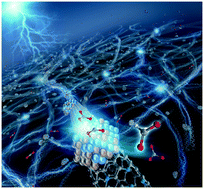An enhanced electrochemical CO2 reduction reaction on the SnOx–PdO surface of SnPd nanoparticles decorated on N-doped carbon fibers†
Abstract
In the electrocatalytic CO2 reduction reaction (CO2RR), tin-based catalysts are known for their high formate faradaic yield. However higher overpotentials are required to attain a high faradaic yield with high partial current density for formate. Here, we describe the increase in the electrocatalytic CO2RR activity of Sn nanoparticles decorated on nitrogen-doped carbon fibers (NCFs) by adding a small amount of Pd. Nitrogen-doped carbon fibers decorated with SnPd nanoparticles (Sn100−yPdy–NCF) of different Sn : Pd ratios were synthesized using the electrospinning method and their electrocatalytic CO2RR activity was studied. The Sn100−yPdy–NCF catalyst with 3 wt% (y = 3) Pd displayed superior activity for the CO2RR and attained a faradaic efficiency of 85%, whereas the NCF with Sn nanoparticles (Sn100–NCF) attained only 57% efficiency at the same potential. The surface electronic configuration, Tafel slope (79 mV dec−1) and bicarbonate reduction activity of the catalyst reveal that the combination of SnOx–PdO on the catalyst surface is responsible for the superior CO2RR activity.



 Please wait while we load your content...
Please wait while we load your content...
